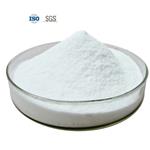- Anagrelide Hydrochloride
-

- $0.00 / 1g
-
2025-01-13
- CAS:58579-51-4
- Min. Order: 1g
- Purity: More Than 99%
- Supply Ability: 100kg/Month
- Anagrelide hydrochloride
-

- $0.00 / 25Kg/Drum
-
2019-10-30
- CAS:58579-51-4
- Min. Order: 25Kg/Drum
- Purity: 98%
- Supply Ability: 1ton
|
| | Anagrelide hydrochloride Basic information |
| Product Name: | Anagrelide hydrochloride | | Synonyms: | 1-b)quinazolin-2(3h)-one,6,7-dichloro-1,5-dihydro-imidazo(monohydrochlorid;6,7-DICHLORO-1,5-DIHYDROIMIDAZO[2,1-B]QUINAZOLIN-2(3H)-ONE MONOHYDROCHLORIDE;ANAGRELIDE HYDROCHLORIDE;BL-4162A;BMY-26538-01;AnagrelideHclC10H7C12N30.HC1;Agryline,HCl;BL-4162A, BMY-26538-01, Agrylin, | | CAS: | 58579-51-4 | | MF: | C10H8Cl3N3O | | MW: | 292.55 | | EINECS: | 680-360-9 | | Product Categories: | Inhibitors;Bases & Related Reagents;Heterocycles;Nucleotides;Intermediates & Fine Chemicals;Pharmaceuticals | | Mol File: | 58579-51-4.mol |  |
| | Anagrelide hydrochloride Chemical Properties |
| Melting point | >280°C | | storage temp. | 2-8°C | | solubility | DMSO: soluble1mg/mL, clear (warmed) | | form | powder | | color | white to beige | | Stability: | Stable for 1 year from date of purchase as supplied. Solutions in DMSO may be stored at -20°C for up to 3 months. | | CAS DataBase Reference | 58579-51-4(CAS DataBase Reference) |
| Hazard Codes | Xn | | Risk Statements | 22-36/37/38 | | Safety Statements | 26 | | WGK Germany | 3 |
| | Anagrelide hydrochloride Usage And Synthesis |
| Description | Anagrelide hydrochloride was launched in the US for thrombocytosis (essential or associated with chronic myelogenous leukemia). The imidazoquinazoline derivative can be prepared from 2,5,6-trichloro-3,4-dihydropyrimidine via alkylation with ethyl bromoacetate followed by heating with ethanolic ammonia or treatment of N-(a-amino- 5,6-dichlorobenzyl)glycine ethyl ester with cyanogen bromide. As a result of its anti-cAMP phosphodiesterase (PDE Ⅲ) activity, Anagrelide hydrochloride was initially tested as a platelet aggregation inhibitor. However it was found that at much lower concentrations it became thrombocytopenic. While the mechanism is not fully understood, it did not shorten platelet survival nor inhibit the formation of colony-forming unitsmegakaryocytes (CFU-M) but primarily interfered with the maturation of megakaryocytes (reduction in size with altered ploidy). It did decrease peripheral vascular resistance and had a positive inotropic effect. | | Chemical Properties | Off-White Powder | | Originator | Roberts (US) | | Uses | Anagrelide Hydrochloride is a phosphodiesterase inhibitor with antiplatelet activity. Used as an antithrombocythemic. Potent PDE3 inhibitor. | | Uses | Signal Transduction Agents, Potent PDE3 inhibitor | | Definition | ChEBI: The hydrochloride salt of anagrelide. | | Manufacturing Process | 6,7-Dicloro-1,2,3,5-tetrahydroimidazo[2,1-b]quinazolin-2-one was produced
from 6-chloro-7-bromo-1,2,3,5-tetrahydroimidazo[2,1-b]quinozolin-2-one by
substitution the bromine an equimolar quantity chlorine.
6-Chloro-7-bromo-1,2,3,5-tetrahydroimidazo[2,1-b]quinazolin-2-one was
produced next way: to a solution of 1.30 g (8 mmole) of anhydrous ferric
chloride in 30 ml of nitromethane was added 1.30 g (5 mmole) of solid 6-
chloro-1,2,3,5-tetrahydroimidazo[2,1-b]quinazolin-2-one and 0.80 g (5
mmole) of bromine. The system was stoppered, warmed to 50°C in an oil
bath overnight, cooled to room temperature and the solvent removed in
vacuo. The resulting solid was suspended in water (50 ml), the mixture was
made basic (pH=10) with sodium bicarbonate and stirred at home
temperature for 20 min. The solid was filtered under suction, washed with
water, then isopropyl alcohol and dried yielding 1.19 g of 6-chloro-7-bromo-
1,2,3,5-tetrahydroimidazo[2,1-b]quinazolin-2-one (78% yield). Purification
was effected by formation of the hydrochloride salt (mp 275°C) from
acetonitrile.
6-Chloro-1,2,3,5,-tetrahydroimidazo[2,1-b]quinazolin-2-one was produced
from 6-chloro-2-nitrobenzylchloride, ethylglycine hydrochloride and cyanogen
bromide in 3 steps. | | Brand name | Agrylin (Shire). | | Therapeutic Function | Platelet aggregation inhibitor | | General Description | Anagrelide belongs to the imidazo[2,1-b]quinazolin-2-one series of compounds. | | Biological Activity | Potent type III phosphodiesterase (PDE3) inhibitor (IC 50 = 36 nM). Inhibits platelet aggregation and produces potent thrombocytopenic effects via inhibition of megakaryocyte maturation. | | Biochem/physiol Actions | Anagrelide is a phosphodiesterase inhibitor with antiplatelet activity (IC50 = 36 nM for inhibition of phosphodiesterase-III). Anagrelide inhibits the maturation of megakaryocytes into platelets, reducing both megakaryocyte hyperproliferation and differentiation. As a drug, anagrelide is antithrombocythemic used for the treatment of overproduction of blood platelets. | | References | 1) Gilespie?et al.?(1988),?Anagrelide: a potent and selective inhibitor of platelet cyclic AMP phosphodiesterase enzyme activity; Biochem. Pharmacol.?37?2866
2) Mazur?et al.?(1992),?Analysis of the mechanism of anagrelide-induced thrombocytopenia in humans; Blood,?79?1931
3) Wang?et al.?(2005),?Comparison of the biological activities of anagrelide and its major metabolites in haematopoietic cell cultures; Br. J. Pharmacol.,?146?324
4) Barbui?et al.?(2012),?Front-line therapy in polycythemia vera and essential thrombocythemia; Blood Rev.,?26?205
5) Chen?et al.?(2012),?Platelet-lowering therapy with anagrelide as an adjuvant therapy for treatment of primary pulmonary neoplasm-associated extreme thrombocytosis; Jpn. J. Clin. Oncol.,?42?761 |
| | Anagrelide hydrochloride Preparation Products And Raw materials |
|